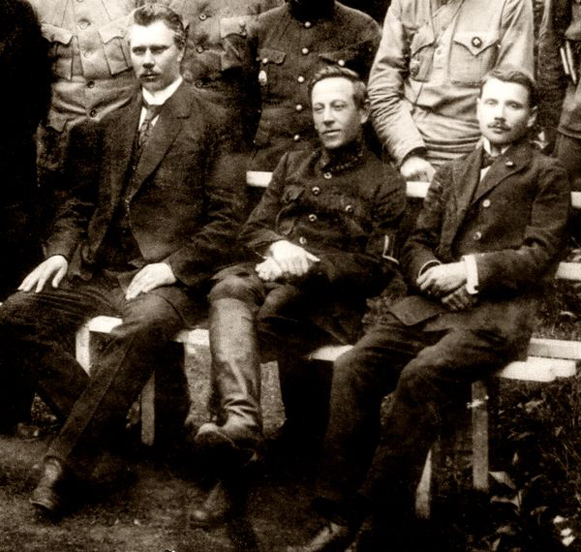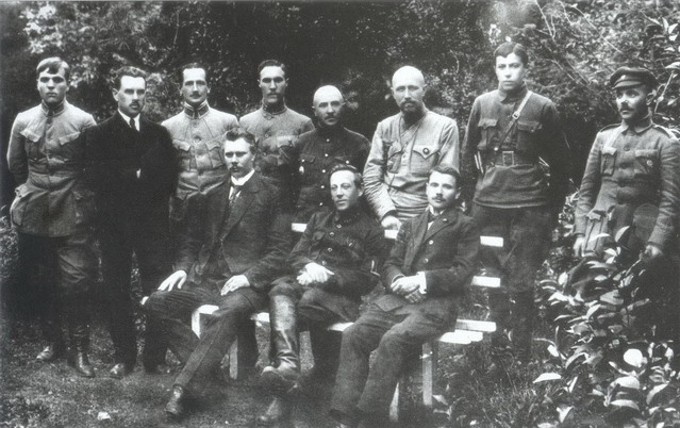Directory of the Ukrainian National Republic
Directory of the Ukrainian National Republic (Директорія УНР; Dyrektoriia UNR). The temporary, revolutionary, state authority created by the Ukrainian National Union on 14 November 1918 for directing the overthrow of Hetman Pavlo Skoropadsky. The uprising against the hetman was hastened by his declaration of a ‘federative union’ with the future non-Bolshevik Russia on that day. At the beginning the Directory was headed by Volodymyr Vynnychenko (representative of the Ukrainian Social Democratic Workers' party), and included the following members: the supreme otaman Symon Petliura (Ukrainian Social Democratic Workers' party and delegate of the Sich Riflemen), Fedir Shvets (representing the Peasant Association), Opanas Andriievsky (Ukrainian Party of Socialists-Independentists), and Andrii Makarenko (non-partisan member, delegate of the railway workers). The Directory formed a temporary government—the Executive Council for State Affairs (Rada Zaviduiuchykh Derzhavnymy Spravamy). The uprising led to Skoropadsky's abdication in favor of his council of ministers, which, in turn, yielded power to the Directory. A new government—the Council of National Ministers of the Ukrainian National Republic—was established by the Directory's decree of 26 December 1918 and was chaired by Volodymyr Chekhivsky. The Directory abolished many of the Hetman government's laws and institutions and restored the legislation of the Central Rada. The most important of these laws dealt with land distribution, the establishment of Ukrainian as the official language, the autocephaly of the Orthodox church, and the convening of the Labor Congress. The Labor Congress met on 23–8 January 1919, and the Directory submitted its powers to the congress—the legislature of the Ukrainian National Republic. In view of the state of war, the Labor Congress empowered the Directory to act as the ‘supreme power and enact laws that are necessary for the defense of the Republic’ and invested the Council of National Ministers with executive power. The ministers were appointed by the Directory and were responsible to it between sessions of the Labor Congress. At the end of March Yevhen Petrushevych, the president of the Ukrainian National Rada of the Western Oblast of the Ukrainian National Republic, joined the Directory, in accordance with a resolution of the Labor Congress, but he did not actually participate in the Directory's work and eventually resigned from it.
On 5 February 1919 the Directory moved from Kyiv to Vinnytsia. Henceforth it frequently changed residence, depending on events at the front. To win the support of the Entente in the Ukrainian-Soviet War, 1917–21, Volodymyr Vynnychenko resigned from the Directory, and Symon Petliura became its head on 11 February. At the same time a new government, without the socialists, was formed and headed by Serhii Ostapenko. When the talks with the Entente collapsed, a new socialist cabinet was formed by Borys Martos in Rivne on 9 April 1919. At the end of August it was replaced by Isaak Mazepa's cabinet. Opanas Andriievsky left the Directory in connection with Otaman Volodymyr Oskilko's uprising.
Only three members remained in the Directory. Their powers were not clearly delineated. Besides carrying out their representative and legislative functions, they sometimes interfered in the affairs of the executive branch and provoked conflicts with the Council of National Ministers.
At a meeting of the Directory and the Council of National Ministers on 15 November 1919 at Kamianets-Podilskyi it was decided that Andrii Makarenko and Fedir Shvets would go abroad on state business and that in their absence ‘the supreme authority in the affairs of the Republic [is] invested in the head of the Directory and the supreme otaman Symon Petliura, who in the name of the Directory will confirm all laws and decrees adopted by the Council of National Ministers.’ On 21 May 1920 the government of the republic issued an order (confirmed by Petliura) recalling the two members of the Directory—Makarenko and Shvets. Their failure to return was considered as a resignation from the Directory. Thus, the Directory ceased to be a collective body. All its powers passed to Petliura.
The ‘Law on the Temporary Supreme Authority and the Legislative System of the Ukrainian National Republic,’ passed on 12 November 1920, gave constitutional sanction to the new one-man Directory as the supreme power of the republic. According to this law, if the head of the Directory became incapable of carrying out his functions, the supreme power would pass to the head of the State People's Council (Derzhavna Narodna Rada). Before this council convened, the supreme power would be entrusted to a college consisting of the head of the cabinet, the chief justice of the Supreme Court, and a representative of the political parties. Until this college was summoned, the head of the Council of National Ministers would replace the head of the Directory. After Petliura's death on 25 May 1926 supreme power was assumed in accordance with this law by the head of the Government-in-exile of the Ukrainian National Republic at the time, Andrii Livytsky.
BIBLIOGRAPHY
Khrystiuk, P. Zamitky i materiialy do istoriï ukraïns'koï revoliutsiï 1917–1920 rr., 3–4 (Vienna 1921–2; repr, New York 1969)
Antonov-Ovsiienko, V. ‘V borot'bi proty Dyrektoriï.’ Litopys revoliutsiï, 1930, nos 1–5
Mytsiuk, O. Doba Dyrektoriï UNR: Spomyny i rozdumy (Lviv 1939)
Mazepa, I. Ukraïna v ohni i buri revoliutsiï 1917–1921, 3 vols (Prague 1942; 2nd edn, Munich 1950–1)
Reshetar Jr., J. The Ukrainian Revolution, 1917–1920: A Study in Nationalism (Princeton, NJ 1952; repr, New York 1972)
Lykholat, A. Razgrom natsionalisticheskoi kontrrevoliutsii na Ukraine (1917–1922 gg.) (Moscow 1954)
Rybalka, I. Rozhrom burzhuazno-natsionalistychnoï Dyrektoriï na Ukraïni (Kharkiv 1962)
Stakhiv, M. Ukraïna v dobi Dyrektoriï UNR, 7 vols (Scranton, PA 1962–6)
Rybalka, I. (ed). Grazhdanskaia voina na Ukraine, 1918-1920: Sbornik dokumentov i materialov, 1 (Kyiv 1967)
Hunczak, T. (ed). The Ukraine, 1917–1921: A Study in Revolution (Cambridge, Mass 1977)
Kuchabsky, V. Western Ukraine in Conflict with Poland and Bolshevism, 1918–1923 (Edmonton–Toronto 2009)
Matvii Stakhiv
[This article originally appeared in the Encyclopedia of Ukraine, vol. 1 (1984).]

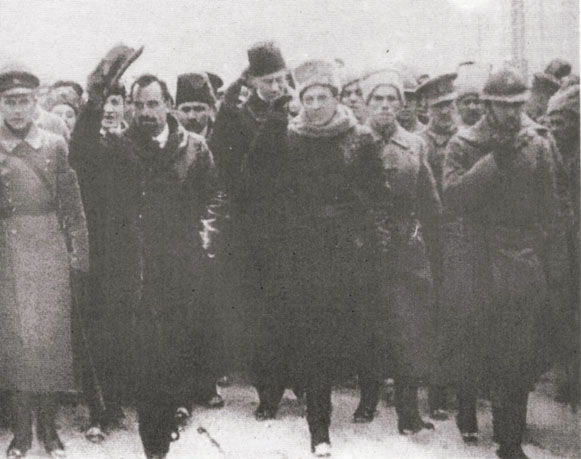
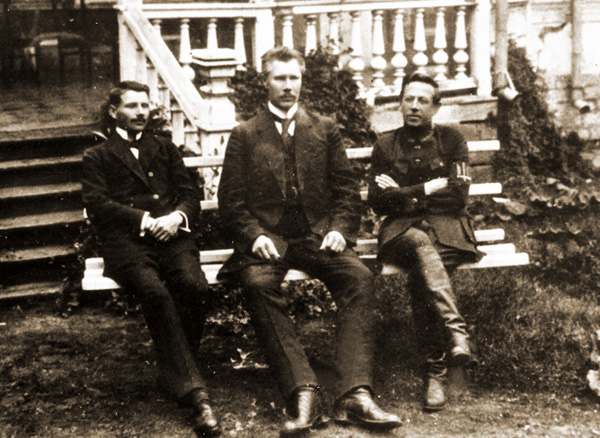
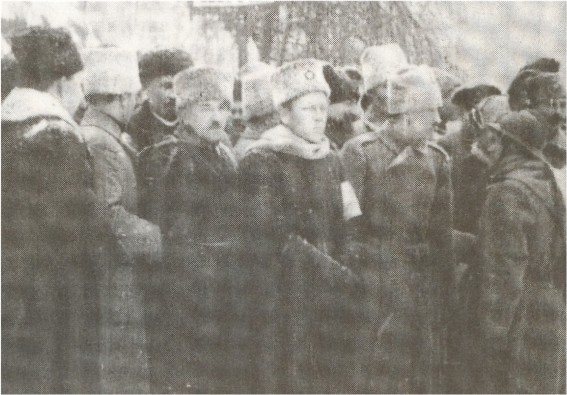
.jpg)
